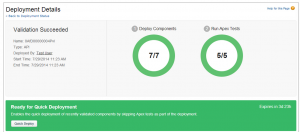Quick Deployments in Salesforce is a powerful feature that speeds up the deployment process by reusing previously validated components, allowing you to skip the lengthy validation step. This tutorial on Salesforcetutorial.com will walk you through the essentials of Quick Deploy, from its requirements to its benefits, and provide clear instructions on how to use it effectively. By mastering Quick Deploy, Salesforce administrators and developers can save valuable time during deployments, making this guide an essential resource for improving release efficiency and minimizing downtime.
What is quick deployment in salesforce ?
Quick deploy is a feature that can deploy components to production environment. This deploying components to production can be done with running test classes on our project release day. Successful validation must be done before our release day.
How quick deploy is useful ?
Deploying code in Salesforce is very hard when our organization contains more number of test methods. Containing more test methods makes our release day will be very long. In order to avoid this type of problems Salesforce.com has provided us a good feature called ” quick deploy “
- Quick deploy option is available for only production environment.
- Quick deploy option is applicable for non production organizations.
- Quick deploy is released as a pilot program for Salesforce production environment.
- To enable this option we have to contact Salesforce.com.
- Quick deploy is available for change sets and meta data API-based deployments.
Key Requirements for Quick Deploy
Quick Deploy is only available when certain conditions are met, ensuring its effectiveness while maintaining data integrity and performance. Here’s a breakdown of these requirements:
| Requirement | Description |
|---|---|
| Validated Deployment | The components must have passed a full validation (including all required tests) within the last 10 days. |
| Unchanged Components | No modifications should be made to the validated components or their dependencies since the last validation. |
| Availability | Quick Deploy can be used in both production and sandbox environments. |
How to perform quick deployment ?
To perform quick deployment in Salesforce.com follow the steps given below.
- First run a validation-only deployment with test execution.
- If our validation succeeds then it qualifies for quick deploy.
- Now Quick deployment option is enabled.
- It appears next to our validation in deployment status page.
Note : Quick deploy option is enables or appears for only qualified validation.

After successful validation of our package, then we can deploy the same deployment with out running any test classes to our production. This option is available for 4 days which is 96 hours for successful validation deployment. This quick deploy is available for last test runs that have passed in last four days.
Benefits of Using Quick Deploy
For Salesforce admins and developers, Quick Deploy offers significant advantages:
- Time Savings: By avoiding repeated validations, Quick Deploy speeds up the deployment process.
- Minimized Downtime: Especially critical in production environments, as Quick Deploy helps to avoid unnecessary delays.
- Simplified Release Management: Quick Deploy makes it easier to manage large releases, particularly useful for those on tight release schedules.
How to Use Quick Deploy in Salesforce
- Validate the Deployment: Start by performing a full validation in your target environment, including all necessary tests.
- Initiate Quick Deploy: Within 10 days of the successful validation, select the Quick Deploy option, allowing you to bypass the validation phase.
This streamlined process ensures that deployments are both fast and secure.
Conclusion
Quick Deploy in Salesforce is an indispensable feature for streamlining your deployment process, cutting down on deployment time, and maintaining system performance. This guide on SalesforceTutorial.com provides all the insights you need to leverage Quick Deploy, ensuring your deployment strategy is both efficient and reliable.